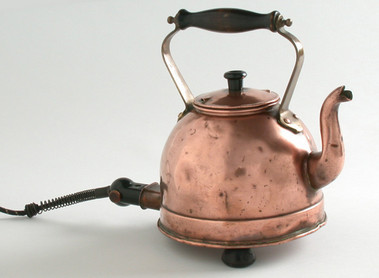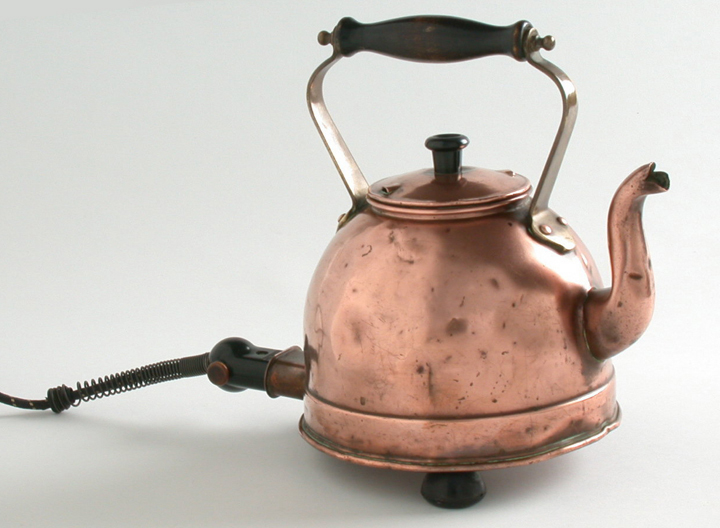Electric Kettle, 1930s, Original
"Put the kettle on" - how often do you use a kettle? Kettles are for boiling water, and are designed to help prevent us burning ourselves in this quite dangerous process.
This copper kettle from the 1930s stands on three Bakelite legs to prevent heat burning the surface on which it stands. It has a removable lid so that the kettle can be filled with water. The lid has a tiny vent to release hot air building up inside the kettle while it boils. A Bakelite knob prevents your fingers touching the hot metal. A large wooden handle attached to the kettle by curved metal posts means you can hold the hot kettle without burning your hand.
The kettle has a socket for a plug to provide the electricity that heats an element inside the kettle. The plug is made of Bakelite, and fabric protects the cord. The element heats up the water. When the water is boiling, steam comes out of the spout and the vent in the lid. This kettle needs to be switched off before it boils dry and begins to burn, unlike many modern kettles that switch off automatically.
This copper kettle from the 1930s stands on three Bakelite legs to prevent heat burning the surface on which it stands. It has a removable lid so that the kettle can be filled with water. The lid has a tiny vent to release hot air building up inside the kettle while it boils. A Bakelite knob prevents your fingers touching the hot metal. A large wooden handle attached to the kettle by curved metal posts means you can hold the hot kettle without burning your hand.
The kettle has a socket for a plug to provide the electricity that heats an element inside the kettle. The plug is made of Bakelite, and fabric protects the cord. The element heats up the water. When the water is boiling, steam comes out of the spout and the vent in the lid. This kettle needs to be switched off before it boils dry and begins to burn, unlike many modern kettles that switch off automatically.

Height:25.5cm
The kettle is a standard household tool - we need boiling water for cooking, cleaning, warmth, washing and sterilising. The electric kettle, first designed by Arthur Large in 1923, has made this common process easier and safer.
Most kettles are used to boil water several times a day. Metal kettles in particular retain heat and a hot handle will burn the user. Using different materials for the handle is a common solution. Plastic, or Bakelite, protects the user from burning. The position of the handle in relation to the body is also important. The handle on many early kettles was positioned over the lid of the kettle. If the lid fell off, or leaked steam, the user could still be scalded. Designers of jug style kettles, developed in the mid twentieth century, positioned the handle on the side of the kettle, thus solving this problem.
The spout of the kettle presents another challenge. Boiling hot water produces steam that can be scalding hot. The spout needs to be pointed away from the body of the kettle to prevent the rising steam billowing onto the user's hand.
Once the water in a kettle begins to boil it starts to evaporate as it converts to steam and escapes through the spout. If no one notices that the water has begun to boil then the kettle will eventually boil dry. When empty, it will begin to burn and melt. To overcome this, designers developed a mechanism in the spout that would make a whistling noise as steam started to pass through, alerting the user to the fact it was boiling. Today, electric kettles have an automatic switch-off device to stop the supply of electricity as the water starts to boil.
Most kettles are used to boil water several times a day. Metal kettles in particular retain heat and a hot handle will burn the user. Using different materials for the handle is a common solution. Plastic, or Bakelite, protects the user from burning. The position of the handle in relation to the body is also important. The handle on many early kettles was positioned over the lid of the kettle. If the lid fell off, or leaked steam, the user could still be scalded. Designers of jug style kettles, developed in the mid twentieth century, positioned the handle on the side of the kettle, thus solving this problem.
The spout of the kettle presents another challenge. Boiling hot water produces steam that can be scalding hot. The spout needs to be pointed away from the body of the kettle to prevent the rising steam billowing onto the user's hand.
Once the water in a kettle begins to boil it starts to evaporate as it converts to steam and escapes through the spout. If no one notices that the water has begun to boil then the kettle will eventually boil dry. When empty, it will begin to burn and melt. To overcome this, designers developed a mechanism in the spout that would make a whistling noise as steam started to pass through, alerting the user to the fact it was boiling. Today, electric kettles have an automatic switch-off device to stop the supply of electricity as the water starts to boil.

Height:25.5cm

"Put the kettle on" - how often do you use a kettle? Kettles are for boiling water, and are designed to help prevent us burning ourselves in this quite dangerous process.
This copper kettle from the 1930s stands on three Bakelite legs to prevent heat burning the surface on which it stands. It has a removable lid so that the kettle can be filled with water. The lid has a tiny vent to release hot air building up inside the kettle while it boils. A Bakelite knob prevents your fingers touching the hot metal. A large wooden handle attached to the kettle by curved metal posts means you can hold the hot kettle without burning your hand.
The kettle has a socket for a plug to provide the electricity that heats an element inside the kettle. The plug is made of Bakelite, and fabric protects the cord. The element heats up the water. When the water is boiling, steam comes out of the spout and the vent in the lid. This kettle needs to be switched off before it boils dry and begins to burn, unlike many modern kettles that switch off automatically.
This copper kettle from the 1930s stands on three Bakelite legs to prevent heat burning the surface on which it stands. It has a removable lid so that the kettle can be filled with water. The lid has a tiny vent to release hot air building up inside the kettle while it boils. A Bakelite knob prevents your fingers touching the hot metal. A large wooden handle attached to the kettle by curved metal posts means you can hold the hot kettle without burning your hand.
The kettle has a socket for a plug to provide the electricity that heats an element inside the kettle. The plug is made of Bakelite, and fabric protects the cord. The element heats up the water. When the water is boiling, steam comes out of the spout and the vent in the lid. This kettle needs to be switched off before it boils dry and begins to burn, unlike many modern kettles that switch off automatically.




















